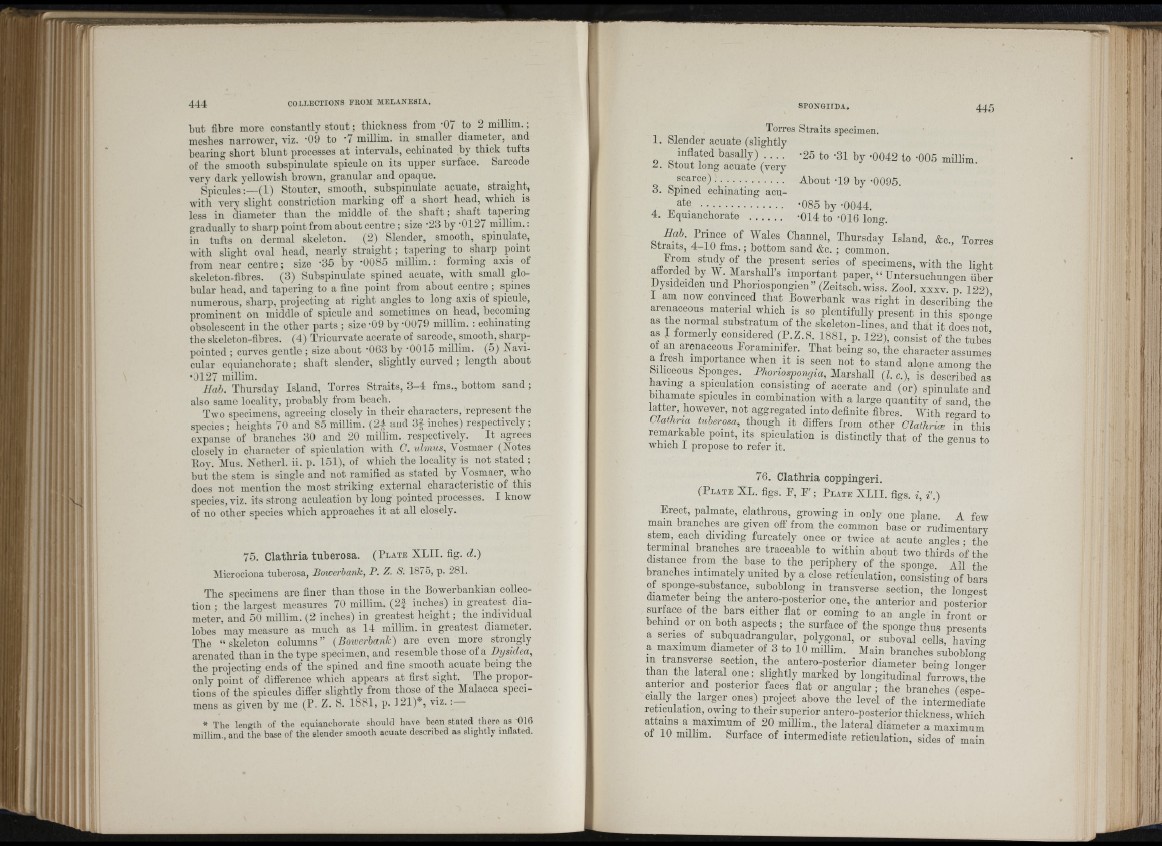
I .
i î l
4*
i "
i f f I I?f ii l^
f if i i
I
î ;
! i
but fibre more constantly s to u t; thickness from ;07 to 2 millim.;
meshes narrower, viz. ‘09 to ‘7 millim. in smaller diameter, and
bearing short blunt processes at intervals, echinated by thick tufts
of the smooth subspinulate spicule on its upper surface. Sarcode
very dark yellowish brown, granular and opaque.
Spicules:—(1) Stouter, smooth, subspinulate acuate, straight,
with very slight constriction marking off a short head, which is
less in diameter than the middle of the s h a f t; shaft tapering
gradually to sharp point from about centre ; size -23 by -0127 millim.:
in tufts on dermal skeleton. (2) Slender, smooth, spinulate,
with slight oval head, nearly stra ig h t; tapering to sharp point
from near centre; size '35 by '0085 millim.: forming axis of
skeleton-fibres. (3) Subspinulate spined acuate, with small globular
head, and tapering to a fine point from about centre ; spines
numerous, sharp, projecting at right angles to long axis of spicule,
prominent on middle of spicule and sometimes on head, becoming
obsolescent in the other parts ; size -09 by -0079 millim. : echinating
the skeleton-fibres. (4) Tricurvate acerate of sarcode, smooth, sharp-
pointed ; curves gentle ; size about •063 by -0015 millim. (5) Navicular
equianchorate; shaft slender, slightly curved ; length about
•0127 millim.
Hah. Thursday Island, Torres Straits, 3—4 fms., bottom sand ;
also same locality, probably from beach.
Two specimens, agreeing closely in their characters, represent the
species; heights 70 and 85 millim. (24 and 3 f inches) respectively;
expanse of branches 30 and 20 millim. respectively. I t agrees
closely in character of spiculation with C. ulmus, Vosmaer (Notes
Roy. Mus. Netherl. ii. p. 151), of which the locality is not stated ;
but the stem is single and not ramified as stated by Vosmaer, who
does not mention the most striking external characteristic of this
species, viz. its strong aculeation by long pointed processes. I know
of no other species which approaches it at all closely.
75. Clathria tuherosa. ( P l a t e XL II. fig. d.)
Microciona tuherosa, Bowerhank, P. Z. S. Ib/o, p. 281.
The specimens are finer than those in the Bowerbankian collection
; the largest measures 70 millim. (2 f inches) in greatest_ diameter,
and 50 millim. (2 inches) in greatest h e ig h t; the individual
lobes may measure as much as 14 millim. in greatest diameter.
The “ skeleton columns” {Boiverhank) are even more strongly
arenated than in the type specimen, and resemble those of a Dysidea,
the projecting ends of the spined and fine smooth acuate being the
only point of difference which appears at first sight. The proportions
of the spicules differ slightly from those oi the Malacca specimens
as given by me (P. Z. S. 1881, p. 121)*, viz. :
* The length of the equianchorate should have been stated there as '016
millim., and the base of the slender smooth acuate described as slightly inflated.
J ' 'f i !■ ^ i'i '
1'.'
445
Torres Straits specimen.
1. Slender acuate (slightly
inflated basally) -25 to -31 by -0042 to -005 millim.
2. Stout long acuate (very
scarce)......................... About -19 by -0095.
3. Spined echinating acuate
.............................. -085 by -0044.
4. Equianchorate ............ -014 to -016 loner Ô *
S tra te ' f Channel, Thursday Island, &c., Torres
Straits, 4 -10 tms. ; bottom sand &c. ; common.
t specimens, with the light
afforded by W. Marshalls important paper, “ Untersuchungen fiber
Dysideiden und Phoriospongien” (Zeitsch.wiss. Zool. xxxv. p. 12 2 1
1 am now convinced th at Bowerbank was right in describino- thé
arenaceous material which is so plentifully present in this sponge
as the normal substratum of the skeleton-lines, and th at it does uot
as I formerly considered (P.Z.S. 1881, p. 122), consist of the tubes’
of an arenaceous Foraminifer. That being so, the character assumes
a fresh importance when it is seen not to stand alone among the
Siliceous Sponges. Phoriospongia, Marshall {I. c.), is described as
having a spiculation consisting of acerate and (or) spinulate and
bihamate spicules in combination with a large quantity of sand the
latter, however, not aggregated into definite fibres. With re-ard to
Clathria tuherosa, though it diflPers from other Olathrioe in this
remarkable point, its spiculation is distinctly th at of the genus to
which I propose to refer it.
76. Clathria coppingeri.
( P l a t e XL. figs. E, F' ; P l a t e X L II. figs. i, {',)
Erect, palmate, clathrous, growing in only one plane. A few
mam branches are given off from the common base or rudimentarv
stem, each dividing furcately once or twice at acute angles • the
terminal branches are traceable to within about two thirds o’f the
distance from the base to the periphery of the sponge All the
branches intimately united by a close reticulation, consisting of bars
of sponge-substance, suboblong in transverse section, the lon-est
diameter bmng the antero-posterior one, the anterior and posterior
surfece of the bars either flat or coming to an angle in front or
behind or on both aspects ; the surface of the sponge thus presents
a series of subquadrangular, polygonal, or suboval cells, havino-
a maximum diameter of 3 to 10 miUim. Main branches suboblon^
in transverse section, the antero-posterior diameter being longer
than the lateral one : slightly marked by longitudinal furrows the
anterior and posterior faces flat or angular ; the branches (especially
the larger ones) project above the level of the intermediate
reticulation, owing to their superior antero-posterior thickness, which
attmns a maximum of 20 millim., the lateral diameter a maximum
of 10 millim. Surface of intermediate reticulation, sides of main
r i d